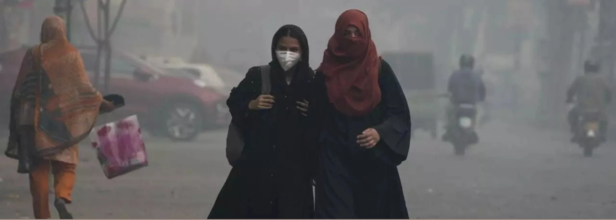- Health Conditions A-Z
- Health & Wellness
- Nutrition
- Fitness
- Health News
- Ayurveda
- Videos
- Medicine A-Z
- Parenting
- Web Stories
Pakistan Declared Health Emergency: Lahore’s AQI Soars to 1600, Does This Impact Indian Cities?

Pakistan Declared Health Emergency: Lahore’s AQI Soars to 1600, Does This Impact Indian Cities?
The Punjab province of Pakistan has declared a health emergency following alarming smog levels, with Lahore recording an Air Quality Index (AQI) of 1,600, one of the highest in the world. The toxic haze has caused widespread respiratory illnesses, prompting urgent government measures to mitigate the crisis.
Senior provincial minister Marriyum Aurangzeb announced the health emergency in Lahore and Multan, citing the severe impact of air pollution on public health. She detailed several measures, including:
- Closure of all educational institutions until further notice.
- Restaurants shutting by 4 p.m., with takeaway services available until 8 p.m.
- Suspension of construction activities in Lahore and Multan.
- Cancellation of time off for medical staff to address the surge in patients.
“Smog is currently a national disaster,” Aurangzeb stated during a press conference, emphasizing that the situation requires long-term intervention.
The smog has affected millions in Punjab, with Lahore reporting over 15,000 cases of respiratory and viral infections in just 24 hours. Health facilities are overwhelmed, treating more than 70,000 individuals daily for smog-related illnesses. Experts warn that young children and the elderly are particularly vulnerable.
Dr. Muhammad Ashraf from Jinnah Hospital Lahore described the crisis as “more of an emergency than COVID-19,” highlighting the mass prevalence of respiratory infections.
Causes and Contributing Factors
The smog, a result of vehicular emissions, industrial activities, construction dust, and crop burning, worsens annually with the onset of the wheat-planting season. Poor air quality has plagued Lahore for 275 days over the past year, accompanied by a 2.3°C rise in temperatures, further exacerbating pollution levels.
What is Government’s Action Plan to Curb Pollution
To combat the crisis, the Punjab government has introduced a 10-year smog mitigation plan targeting transport, energy, agriculture, and public behavior. Measures include:
- Mask mandates and reduced workplace operations.
- Temporary bans on large gatherings and weddings to minimize emissions.
- Encouraging online learning as a contingency for school closures.
Despite the interventions, experts caution that smog cannot be resolved quickly. Punjab’s Secretary for Environment, Raja Jahangir Anwar, warned of prolonged closures if air quality fails to improve.
Data from IQAir, a Swiss air monitoring organization, ranked Lahore as the most polluted city globally, with several areas recording AQI levels exceeding 1,000. The city’s deteriorating air quality has drawn international concern, as it continues to pose severe health risks to its 11 million residents.
With rain and wind expected in the coming days, authorities hope for temporary relief from the hazardous smog. However, Aurangzeb reiterated the need for sustained efforts to combat the environmental and health crisis, calling for collective action to reduce pollution and protect public health.
As Lahore and Multan endure unprecedented pollution levels, the health emergency serves as a stark reminder of the urgent need for effective policies and long-term solutions to address air quality challenges in Pakistan.
Does This Impact India too?
The worsening air quality in Pakistan's Punjab, particularly Lahore, could impact India as well, especially in bordering regions. Transboundary air pollution may exacerbate smog levels in Northern India, affecting health and daily life.
Mounjaro Price Increase: Eli Lilly to Hike UK Cost of Weight-Loss Drug by 170%

Credits: Canva
Eli Lilly will significantly increase the UK price of its weight-loss and diabetes drug Mounjaro from September. The company says the rise is intended to align UK costs with those in other developed nations and address pricing disparities. The US pharma giant has announced it will raise the price of its popular drug, also prescribed for type 2 diabetes, by as much as 170 per cent.
According to Lilly, the hike will bring UK prices more in line with other wealthy nations in Europe and beyond.
The NHS Gets a Pass… For Now
Know that the NHS won't be hit by this increase. The higher prices are aimed squarely at private patients and providers, who can negotiate hush-hush discounts behind closed clinic doors. Reports suggest that the highest monthly dose will leap from £122 to £330, while lower doses will see bumps between 45 and 138 per cent.
If you have been relying on Mounjaro as your secret weapon against stubborn kilos, this could be the financial equivalent of your personal trainer suddenly charging three times more for the same number of push-ups.
Life Without the Jab
Of course, for some, the looming price jump is more than a budget annoyance; it is a motivation crisis. But you do not actually need to stick a needle in your thigh to get “Mounjaro-like” weight loss.
Here is how to hack your habits so your body thinks it is on the metabolism-boosting fast track, without any pharmaceutical intervention.
Eat Like You Mean It
Most of what Mounjaro does can be replicated through daily habits. Step one? Food. High-protein, high-fibre, healthy-fat meals keep you full longer, suppress sugar cravings, and make overeating less tempting. Avoid large meals, sugar, and processed food. And slow, mindful eating gives your brain time to catch up with your stomach.
Even your water bottle can become a weight-loss tool. A lot of what people think is hunger is actually dehydration. Electrolyte-rich water—with sodium, potassium, and magnesium—can curb cravings and keep energy levels stable.
Pick Up Heavy Things
While pounding the treadmill has its place, strength training is the real game-changer for long-term fat loss. Muscle tissue burns more calories at rest than fat. Plus, medications like Mounjaro and Ozempic can cause muscle loss if you are not lifting weights, leading to a slimmer but softer physique. Resistance training preserves muscle and shapes the body more effectively.
Sleep, Stress, and Staying the Course
Before you dismiss rest as “lazy time”, remember it is a weight-loss essential. Poor sleep and chronic stress raise cortisol and blood sugar, making fat loss harder. Consistency is king. A regular schedule for eating, exercising, and resting does more for your metabolism than any magic shot.
Surgery, Skincare, and Staying Realistic
Medication-induced weight loss can come with aesthetic and medical trade-offs. Rapid weight loss often means loose, sagging skin, and there are reports linking GLP-1 drugs to inflammatory issues and even certain cancers.
There are alternatives that avoid the “melted candle” effect of sudden slimming. Swallowable balloons reduce stomach capacity gradually, minimising skin laxity. For sculpting, there is 360 body contouring or liposuction with skin-tightening tech.
If you are needle-shy but still chasing definition, go for cryotherapy or lipolytic injections for stubborn fat. They are great for shape refinement, not full-body weight loss.
When the Price Tag Becomes the Push
For many, the new Mounjaro pricing might be the gentle nudge needed to ditch the drug and rediscover the old-school ways of getting lean: mindful eating, muscle-building, and sleep that actually lets your body recover.
The reality is, drugs like Mounjaro can be revolutionary for people with serious metabolic issues, but for those using it as a shortcut, the financial bite may soon feel sharper than the injection. Whether you keep your jab or kick it, remember that sustainable weight loss has always been less about the price tag on your medicine cabinet and more about the habits that shape your daily life.
XFG ‘Stratus’ COVID Now Dominant in US: States With Highest Cases and How to Spot Unique Symptoms

Credits: Canva
The XFG “Stratus” COVID-19 variant is officially strutting into the pandemic spotlight. It is new, it is bold, and according to the latest data from the Centres for Disease Control and Prevention (CDC), it is now the third most common variant in the US. But it is popping up in certain states more than others, and the way it announces its arrival could be by making your throat feel like you have swallowed a box of sandpaper.
While the national Covid-19 test positivity rate sits in the 5–9.9 per cent range, a dozen states are seeing significantly higher numbers.
According to CDC data, the states with the highest positivity rates are:
- New Mexico (12%)
- Texas (12%)
- Oklahoma (12%)
- Arkansas (12%)
- Louisiana (12%)
- Nevada (11.3%)
- Arizona (11.3%)
- California (11.3%)
- Alaska (11.1%)
- Washington (11.1%)
- Oregon (11.1%)
- Idaho (11.1%)
These states are not just reporting higher numbers but are also providing ideal conditions for Stratus to spread. With case trends officially “growing” according to the CDC, it is a situation that demands close attention.
Stratus is a variant under monitoring by the World Health Organisation (WHO). First detected in January, XFG Stratus now accounts for about 14 per cent of Covid cases in the US.
While theW says the health risk from Stratus remains low at a global level, this variant is still on a growth spurt, outpacing other circulating forms of the virus, including its sibling, the “Nimbus” NB.1.8.1 variant. The concerning bit is that the WHO says Stratus could be more adept at sidestepping immune defences. The reassuring bit is that the current vaccines are expected to continue protecting against symptomatic and severe disease caused by Stratus.
Spotting Unique Stratus Symptoms
The tricky thing about Stratus is that it is not trying to reinvent the Covid symptom wheel. According to experts, its symptoms look suspiciously similar to other recent Omicron descendants. But there is one possible stand-out, a sensation some patients are calling “razor blade throat”.
Here’s the full checklist:
- Sore throat (sometimes severe)
- Cough
- Congestion or runny nose
- Fever or chills
- Shortness of breath
- Loss of taste or smell
- Fatigue
- Headache
- Muscle aches
- Nausea, vomiting or diarrhoea
The “razor blade throat” description might sound too much, but anyone who has had that burning, scratchy pain knows it is no joke. Hoarseness has also been reported more often lately. Still, a sore throat has been a hallmark Covid symptom since the early days of the pandemic; Stratus just seems to be leaning into it.
Why the Positivity Spike Matters
Higher positivity rates do not just mean more people are testing positive; they can also signal under-testing. If more than 10 per cent of people tested are infected, it suggests many cases are flying under the radar, which means more opportunities for the virus to spread unchecked. That is especially risky when you have a variant with a knack for growing its share of cases quickly, like Stratus.
The fact that 12 states are sitting above the 11 per cent mark means public health teams will be watching these regions closely in the coming weeks. In the meantime, everyday precautions like masking in crowded places, testing if symptomatic, and staying up to date with vaccines remain the best tools in the toolbox.
Stratus vs. Nimbus
While Stratus is currently the one hogging headlines, it is not alone. The “Nimbus” NB.1.8.1 variant is still in the mix, though it is being outpaced by Stratus globally.
For now, Stratus is the one to watch and not because it is the most dangerous, but because it is the fastest climber.
Final Forecast
The XFG Stratus variant is not changing anything, but it is a reminder that the virus is still evolving and still finding ways to make itself known. Got a sudden sore throat that feels like sandpaper? Do not brush it off. Stratus may not be a storm you can see on a weather map, but it is definitely in the air.
UK Health Chiefs Warn of Rising Cases of Deadly Chikungunya Virus That Can Cause Body to ‘Fold In on Itself’

Credits: Canva
Health authorities in the UK have reported a significant rise in chikungunya cases, a mosquito-borne disease known for causing severe joint pain that can leave sufferers hunched over. Between January and June 2025, there were 73 confirmed cases in England, Wales, and Northern Ireland, more than double the 27 recorded during the same period in 2024. The UK Health Security Agency (UKHSA) says this is the highest number ever recorded, with nearly all linked to overseas travel.
What is Chikungunya?
Spread by the bite of infected Aedes mosquitoes, particularly the Aedes aegypti and Aedes albopictus species, chikungunya is not usually deadly but can be devastating for the very young, the elderly, or those with underlying health conditions.
Typical symptoms include:
- Excruciating joint pain that can leave sufferers bent over in agony
- High fever and headaches
- Muscle aches and swelling in the joints (especially hands and feet)
- Nausea, fatigue, and a rash that’s red, bumpy, and decidedly not Instagrammable
In severe cases, the arthritis-like pain can linger for months or even years, turning every movement into a reminder that mosquitoes are not just a mild holiday nuisance.
The majority of UK cases this year were linked to travel to Sri Lanka, India, and Mauritius. All were reported in England, with London taking the dubious honour of having the most cases. However, the two mosquito species that spread the virus are not established in the UK, so there is no risk of it transmitting locally.
UK logs first cases of oropouche virus
As if one virus was not enough, the UK has also logged its first cases of the oropouche virus, also dubbed ‘sloth fever’. This one circulates in the wild between primates, sloths, and birds before occasionally hopping over to humans via midges or mosquitoes.
Found primarily in the Amazon basin, oropouche has recently started wandering further across the Americas. All the UK cases were linked to travel from Brazil, so unless your staycation involves tree-dwelling mammals and tropical insects, you are safe for now.
The Global Bug Crawl
Chikungunya is typically found in Africa and southern Asia, but 2025 has seen it pop up in unexpected places. Outbreaks have been reported in China, the Indian Ocean islands of Reunion, Mayotte and Mauritius, and across the Americas. In southern China, more than 7,000 people have been infected since June, prompting COVID-style lockdowns in Foshan and at least a dozen other cities in Guangdong province. Hong Kong and Taiwan have also reported cases.
Health officials are urging travellers to take bite prevention seriously.
How to safeguard against mosquito bites
According to the US Centres for Disease Control and Prevention (CDC), your best defence is to stop mosquitoes from making contact in the first place.
Top tips include:
- Use Environmental Protection Agency (EPA)-registered insect repellent
- Wear long-sleeved shirts and trousers (mosquitoes can’t bite what they can’t reach)
- Treat clothing and gear with 0.5% permethrin for extra armour
- Choose accommodation with air conditioning or window screens
- If sleeping outdoors, use a mosquito net unless you enjoy sharing your bed with the local insect population
Vaccination
In addition to covering up and dousing yourself in repellent, some travellers may be advised to get the chikungunya vaccine before heading to certain destinations. Your healthcare provider can help you decide if this applies to your travel plans.
Why the Surge Now?
Several factors could be behind the sharp rise in cases. Increased international travel post-pandemic, changing weather patterns favouring mosquito breeding, and outbreaks in popular holiday destinations have created a perfect storm. Mosquitoes thrive in warm, wet conditions, and with climate change extending those conditions into more regions, these viruses are no longer staying politely within their old borders.
Chikungunya virus can turn a dream getaway into a painful endurance test, and once contracted, it is all about managing symptoms; there is no cure. The same goes for oropouche: prevention is your best friend. In the world of tropical diseases, an ounce of repellent really is worth a pound of cure.
© 2024 Bennett, Coleman & Company Limited

